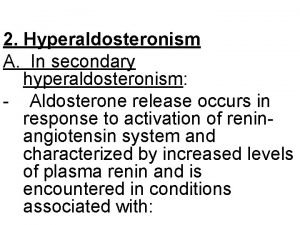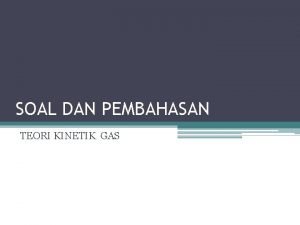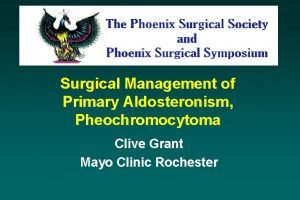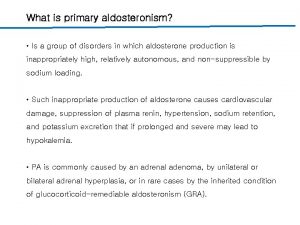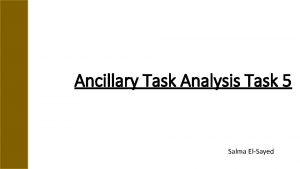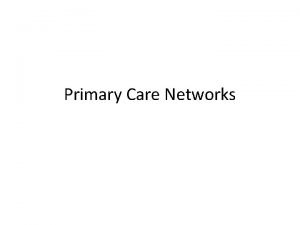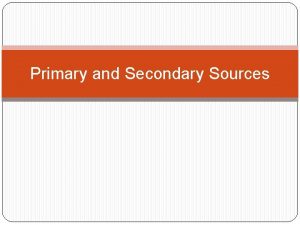In The Name of God Primary Aldosteronism Salma


















































- Slides: 50

In The Name of God Primary Aldosteronism Salma Ahi, MD Fellow of Endocrinology Research Institute of Endocrine Sciences 2013 october

Clinical questions: § why is PA important ? § who should be screened for PA? § How to perform screening and confirmatory tests? § How to Lateralize the lesion without access to AVS? § Outcome after treatment of PA

Background Why is PA important? This condition is important not only because of its prevalence, but also because PA patients have higher cardiovascular morbidity and mortality than age- and sex-matched patients with essential hypertension and the same degree of blood pressure elevation. Furthermore, specific treatments are available that ameliorate the impact of this condition on patientimportant outcomes.

Ø A 38 yrs old female referred to our center for evaluation of resistant HTN & hypokalemia Ø She was hypertensive for the past 8 months under the care of a cardiologist Her medications included Losartan (50 mg/d), Aldactone (25 mg/d), Metoprolol (100 mg/d) and Hydrochlorothiazide (25 mg/d)

Ø PMH: HTN § Claims that his BP levels were almost always in the range of 150 -160/90 -100 mm. Hg § Not smoker § negtive history for use of herbal medications

Ø BP=160/110 mm. Hg Ø Eyes; Heart; Lungs: Unremarkable Ø Muscle force: 3/5 +4/5 Ø Serum potassium level was 3. 1 meq/L Ø Retrospective search in her lab data revealed a serum potassium level of 2. 8 meq/L in about one months ago; she was unaware about this matter and had not been treated for hypokalemia at that time

Hospital Course: Ø She was treated with oral and IV potassium Ø Her antihypertensive drugs changed to Diltiazem (60 mg twice daily) and Prazosin (4. 5 mg daily) Ø Symptoms improved within 48 h Ø BP was 140 -155/80 mm. Hg and serum potassium level became normal (4 meq/L)

Lab Data: Hb=14. 5 Cr=0. 9 (GFR=87), Na=140, Mg=1. 8, Ca=8. 8, P=2. 5 K: 2. 9 3. 1 4 PH=7. 43, HCO 3=29, Pco 2=45 U/A: SG=1015; Pr (-); RBC=8 -10 FBS=90, TG=171, Chol=168 LFT: Nl TFT: Nl (on LT 4 Tx)

Other Paraclinical Data: § EKG: NSR; Nl axis; No significant ST-T change § Echocardiography: EF=60%; Mild LVH Mild MR & AI § Urinary tract sonography & Doppler exam. : Normal sized kidneys Nl renal arteries

Case Detection: WHO? 1) JNC stage 2 and 3 HTN (8% and 13%) 2) Resistant HTN (17 -23%) 3) HTN and spontaneous or diuretic-induced hypokalemia (? ) 4) HTN and adrenal incidentaloma (1. 1 -10%) ) HTN and a family history of early-onset HTN or CVA at a young age(<40 ys)


Case Detection: HOW? q ARR (plasma aldosterone-renin ratio) § Medications with minimal effects on plasma I. aldosterone levels: II. III. Non-dihydropyridine Ca channel blockers (Verapamil) Vasodilators (Hydralazine) Alpha-adrenergic blockers (Prazosin, Doxazosin, Terazosin)

Measurement of the aldosterone-renin ratio: a suggested approach A. Preparation for aldosterone-renin ratio (ARR) measurement: B. 1. Attempt to correct hypokalemia, after measuring plasma potassium in blood collected slowly with a syringe and needle [preferably not a Vacutainer to minimize the risk of spuriously raising potassium], C. Avoiding fist clenching during collection, D. Waiting at least 5 seconds after tourniquet release to achieve insertion of needle, and E. Ensuring separation of plasma from cells within 30 minutes of collection.

2. Encourage patient to liberalize sodium intake. 3. Withdraw agents that markedly affect the ARR for at least 4 weeks: q. Spironolactone, eplerenone, amiloride, and triamterene q. Potassium-wasting diuretics q. Products derived from liquorice root (e. g. , confectionary licorice, chewing tobacco)

4. If the results of ARR off the above agents are not diagnostic, withdraw other medications that may affect the ARR for at least 2 weeks: q. Beta-adrenergic blockers, q central alpha-2 agonists (e. g. , clonidine, alphamethyldopa), q NSAID drugs q. Angiotensin-converting enzyme inhibitors, angiotensin receptor blockers renin inhibitors q. Dihydropyridine calcium channel antagonists

5. If necessary to maintain hypertension control, commence other antihypertensive medications that have lesser effects on the ARR (e. g. , verapamil slow-release, hydralazine [with verapamil slow-release, to avoid reflex tachycardia], prazosin, doxazosin, terazosin;

6. Establish oral contraceptive (OC) and hormone replacement therapy (HRT) status, as estrogencontaining medications may lower direct renin concentration (DRC) and cause false positive ARR when DRC (rather than plasma renin activity) is measured. Do not withdraw OC unless confident of alternative effective contraception.

Conditions for collection of blood 1. Collect blood mid-morning, after the patient has been up (sitting, standing, or walking) for at least 2 hours and seated for 5 -15 minutes. 2. Collect blood carefully, avoiding stasis and hemolysis. 3. Maintain sample at room temperature (and not on ice, as this will promote conversion of inactive to active renin).

Factors to take into account when interpreting results q. Age: in patients aged >65 years, renin can be lowered more than aldosterone by age alone, leading to a raised ARR q. Time of day, recent diet, posture, and length of time in that posture q. Medications q. Method of blood collection, including any difficulty doing so q. Level of potassium q. Level of creatinine (renal failure can lead to false positive ARR)

Factors that may lead to false-negative or false-positive ARR results:

Factors that may lead to falsenegative or false-positive ARR results:


ARR cut-off values:

Our Case: ü Two months after change of his medications: PAC=40 ng/d. L PRA<0. 01 ng/m. L/h ARR>4000

Case Confirmation: q Four testing procedures: (No gold standard) 1. 2. 3. 4. Oral sodium loading test Saline infusion test (SIT) Fludrocortisone suppression test Captopril challenge test *Choice: cost, compliance, lab routine, local expertise

SIT: § Lack powerful study designs for establishing the test accuracy • Sensitivity: 83 -88% • Specificity: 75 -100%

SIT:

Sensitivity and Specificity of Salt Loading Test:




Our Case: ü SIT: PAC (ng/d. L) PRA (ng/m. L/h) Cortisol (micg/d. L) Potassium (mg/d. L) PAC/Cortisol Start 30. 2 0. 01 20 4 1. 51 End 41. 7 0. 01 8. 7 3. 3 4. 8

Subtype Classification: q Adrenal CT scan q Adrenal venous sampling (AVS): If surgical treatment is practicable and desired by the patient To distinguish between unilateral and bilateral adrenal disease q Ancillary tests

Adrenal CT Scan: Ø APA: usually < 2 cm, hypodense nodule Ø IHA: normal-appearing or unilateral or bilateral nodular changes Ø Aldosterone-producing adrenal carcinomas: almost always > 4 cm and with suspicious imaging phenotype • Sensitivity: 48 -58%; Specificity: 90% • Several Limitations especially in older patients (>40 yr), thus: AVS is essential to direct appropriate therapy

Our Case: ü Adrenal CT scan: A 10 mm mass with soft tissue density in lateral limb of left adrenal

Unsuccessful or unavailable AVS: 1) 2) 3) § § Repeat AVS Treat with MR antagonist Consider surgery based on the other studies: Adrenal CT Scan Posture Stimulation Test § Morning Recumbent 18 -OHB levels Not available Low accuracy

Posture Stimulation Test: § The absence of the significant increase (<30%) of PAC at the upright posture supports the diagnosis of APA § Test accuracy: 85% Fontes RG, Am J Hypertens 1991; 4: 786 -91 Young WF, Endocrinol Metab Clin North Am 1988; 17: 367 -95 § The fall in PAC during 4 h erect posture has PPV of 100% for diagnosis of unilateral lesion Espiner EA, J Clin Endocrinol Metab 2003; 88: 3637 -44

18 -Hydroxycorticosterone levels Patients with APA generally have recumbent plasma 18 -OHB levels greater than 100 ng/d. L at 8: 00 a. m. , whereas patients with IHA have levels that are usually less than 100 ng/Dl. However, this test lacks the accuracy needed to guide the clinician in the subtype evaluation of PA

Iodocholesterol scintigraphy Because tracer uptake was poor in adenomas smaller than 1. 5 cm in diameter, this method often is not helpful in interpreting micronodular findings obtained with highresolution CT and rarely plays a role in subtype evaluation. Currently it is no longer used.

Our Case: ü Posture Stimulation Test: overnight recumbent PAC (ng/d. L) PRA (ng/m. L/h) 39 0. 01 PAC increase: 8. 8 ng/d. L (22. 5%) 2 h ambulation 47. 8 0. 01

Summary of Diagnostic Studies: Ø ARR > 4000 ng/d. L per ng/m. L/h Ø Post-infusion PAC= 41. 7 ng/d. L Ø Post-infusion PAC/Cortisol= 4. 8 ng/d. L per micg/d. L (in favor of APA) Ø Positive posture stimulation test (in favor of APA) Ø An adenoma on CT scan

Diagnosis Aldosterone-producing Adenoma

Ddx: GRA In patients with q onset of confirmed PA earlier than at 20 years of age and q in those who have a family history of PA or of strokes at young age, suggest genetic testing for GRA.

Management: Ø Recommendation of endocrine society guideline (2008): Documented unilateral PA: Unilateral laparoscopic adrenalectomy* * No high quality evidence linking adrenalectomy with improved Qo. L, morbidity or mortality * Because adrenalectomy can either eliminate the need for medication or reduce medication side effects (more cost-effective than lifelong medical therapy), is the preferred treatment

Outcome After Adrenalectomy: Ø Cure of HTN (<140/90 mm. Hg): 44% (95% CI: 31 -56%) Ø Improvement of BP control: 90 -100%

Outcome After Adrenalectomy: q Predictors of complete resolution of HTN: § <=2 preoperative antihypertensive drugs** § <=1 first-degree relative with HTN** § Younger age § Shorter duration of HTN (< 6 years) § Lower BMI § Female sex § Higher preoperative ARR § Higher urinary aldosterone secretion § Positive preoperative response to Spironolactone § APA size of <= 20 mm

Outcome After Adrenalectomy: q Aldosteronoma Resolution Score (ARS): 4 preoperative variables: Score Taking <=2 antihypertensive medications 2 BMI <=25 kg/m 2 1 Duration of HTN <=6 years 1 Female sex 1 § The greater the ARS, the greater the resolution of HTN after adrenalectomy (NPV=72. 4% for ARS=0 -1 and PPV=75% for ARS=4 -5)


A Clinical Prediction Score to Diagnose Unilateral Primary Aldosteronism • A cross-sectional diagnostic study at a single center • Objective: Identification of patients` characteristics that can predict unilateral aldosterone hypersecretion hence bypass AVS before surgery • 101 patients with PA • Main outcome measures: Variables independently associated with lateralized AVS

• Results: All 26 patients with a typical Conn`s adenoma plus serum potassium < 3. 5 meq/L or e. GFR of at least 100 ml/min/1. 73 m 2 or both had unilateral PA Sensitivity: 53% (CI: 38 -68) Specificity: 100% (CI: 91 -100) 23 Kupers EM; J Clin Endocrinol Metab. 2012 Aug
 Kahn
Kahn Secondary aldosteronism
Secondary aldosteronism Hyperaldosteronism
Hyperaldosteronism Yeni salma barlinti
Yeni salma barlinti Salma acronym georgia
Salma acronym georgia Salma slide girl
Salma slide girl Contoh soal teori kinetik gas
Contoh soal teori kinetik gas Yeni salma barlinti
Yeni salma barlinti Yeni salma barlinti
Yeni salma barlinti Santa veronica giuliani corpo incorrotto
Santa veronica giuliani corpo incorrotto Salma berrada souni
Salma berrada souni Gcg menurut para ahli
Gcg menurut para ahli Name all rays
Name all rays Hát kết hợp bộ gõ cơ thể
Hát kết hợp bộ gõ cơ thể Lp html
Lp html Bổ thể
Bổ thể Tỉ lệ cơ thể trẻ em
Tỉ lệ cơ thể trẻ em Chó sói
Chó sói Thang điểm glasgow
Thang điểm glasgow Hát lên người ơi alleluia
Hát lên người ơi alleluia Các môn thể thao bắt đầu bằng tiếng chạy
Các môn thể thao bắt đầu bằng tiếng chạy Thế nào là hệ số cao nhất
Thế nào là hệ số cao nhất Các châu lục và đại dương trên thế giới
Các châu lục và đại dương trên thế giới Công thức tính thế năng
Công thức tính thế năng Trời xanh đây là của chúng ta thể thơ
Trời xanh đây là của chúng ta thể thơ Cách giải mật thư tọa độ
Cách giải mật thư tọa độ Phép trừ bù
Phép trừ bù Phản ứng thế ankan
Phản ứng thế ankan Các châu lục và đại dương trên thế giới
Các châu lục và đại dương trên thế giới Thể thơ truyền thống
Thể thơ truyền thống Quá trình desamine hóa có thể tạo ra
Quá trình desamine hóa có thể tạo ra Một số thể thơ truyền thống
Một số thể thơ truyền thống Cái miệng bé xinh thế chỉ nói điều hay thôi
Cái miệng bé xinh thế chỉ nói điều hay thôi Vẽ hình chiếu vuông góc của vật thể sau
Vẽ hình chiếu vuông góc của vật thể sau Nguyên nhân của sự mỏi cơ sinh 8
Nguyên nhân của sự mỏi cơ sinh 8 đặc điểm cơ thể của người tối cổ
đặc điểm cơ thể của người tối cổ Thế nào là giọng cùng tên? *
Thế nào là giọng cùng tên? * Vẽ hình chiếu đứng bằng cạnh của vật thể
Vẽ hình chiếu đứng bằng cạnh của vật thể Fecboak
Fecboak Thẻ vin
Thẻ vin đại từ thay thế
đại từ thay thế điện thế nghỉ
điện thế nghỉ Tư thế ngồi viết
Tư thế ngồi viết Diễn thế sinh thái là
Diễn thế sinh thái là Dạng đột biến một nhiễm là
Dạng đột biến một nhiễm là Số nguyên tố là số gì
Số nguyên tố là số gì Tư thế ngồi viết
Tư thế ngồi viết Lời thề hippocrates
Lời thề hippocrates Thiếu nhi thế giới liên hoan
Thiếu nhi thế giới liên hoan ưu thế lai là gì
ưu thế lai là gì Khi nào hổ con có thể sống độc lập
Khi nào hổ con có thể sống độc lập


